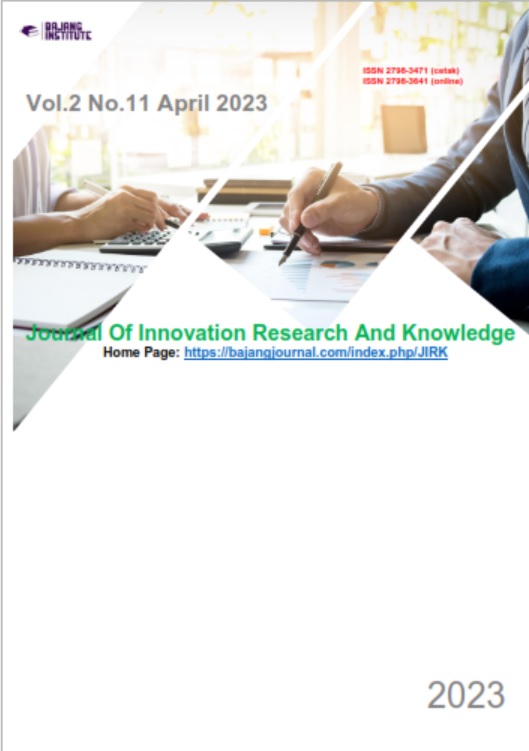DENGUE FEVER WITH WARNING SIGN (CASE REPORT)
DOI:
https://doi.org/10.53625/jirk.v2i11.5476Keywords:
Dengue fever, warning signs, virusAbstract
Dengue Hemorrhagic Fever (DHF) is a disease infection caused by the dengue virus that enters the circulatory system through the bite of a vector, namely the Aedes aegypti, characterized by plasma leakage. Dengue virus infects endothelium, bone marrow, and Kupffer cells in the liver so that activates the immune system which occurs excessively. Thrombocytopenia occurs due to bone marrow suppression, destruction, and shortening of the life of platelets which interfere with the coagulation system, causing bleeding.
We describe a case of a 42-year-old man admitted to the intensive care unit who was diagnosed with dengue fever with a warning sign. In this case, besides complaint of fever, there is also the existence of pain in the pit of the heart, and gums bleeding. During the monitoring process in the room, there are other symptoms such as rash on the skin, nausea, vomiting, persistent heartburn, the difficulty for sleep, also minimal ascites. On laboratory result, hematocrit starts increasing and accompanied with the drop of platelets 50000/mm3 with Ht 49.8%, so that patient is transferred to ICU for monitoring intensively and prevent entering severe dengue.
This patient has platelets decrease until reaches 13,000/mm3 and hematocrit reached 48.1% shows the weight clinical that will be experienced patient. The patient who experiences ascites that becomes a predictor will occurrence of DSS so that has a prognosis of dubia. The prognosis for dengue without or with warning signs is generally good.
References
Ahmad S, Anwar F, Ullah I, Alam M, Khan J, Abid-ur-Rehman FA, et al. Epidemiological and clinical manifestation of dengue virus infection: A Recent Report of 2018 from District Battagram Khyber Pakhtunkhwa. International Journal of Mosquito Research. 2020;7(6 Part A):5-8.
Touret F, Baronti C, Goethals O, Van Loock M, de Lamballerie X, Querat G. Phylogenetically based establishment of a dengue virus panel, representing all available genotypes, as a tool in dengue drug discovery. Antiviral Research. 2019;168:109-13.
Danis‐Lozano R, Díaz‐González EE, Malo‐García IR, Rodríguez MH, Ramos‐Castañeda J, Juárez‐Palma L, et al. Vertical transmission of dengue virus in Aedes aegypti and its role in the epidemiological persistence of dengue in Central and Southern Mexico. Tropical Medicine & International Health. 2019;24(11):1311-9.
World Health Organization. Dengue and severe Dengue. https://www.who.int/news-room/fact-sheets/detail/Dengue-and-severe Dengue.2020. (Accessed April 7 th 2020).
Dehghani R, Kassiri H. A review on epidemiology of dengue viral infection as an emerging disease. Research Journal of Pharmacy and Technology. 2021;14(4):2296-301.
Harapan H, Michie A, Mudatsir M, Sasmono RT, Imrie A. Epidemiology of Dengue hemorrhagic fever in Indonesia: analysis of five decades data from the National Disease Surveillance. BMC Res Notes. 2019;12(1):350.
Indonesian Ministry of Health Data and Information Center. The Situation of Dengue Fever Disease in Indonesia in 2017. Ministry of Health. 2018:1-6.
Indriyani, Desak Putu Rendang, I Wayan Gustawan. Clinical manifestations with the management of dengue hemorrhagic fever grade 1: a literature review. Medical Science Digest. 2020;(11):2.
Tansil, Melissa G., Novie H. Rampengnan, Rocky Wilar. Risk Factors for the Occurrence of Dengue Hemorrhagic Fever in Children. Biomedical Journal. 2021;(13):1.
King CA, Wegman AD, Endy TP. Mobilization and activation of the innate immune response to dengue virus. Frontiers in Cellular and Infection Microbiology. 2020:640.
Hadinegoro SR, Moedjito I, Hapsari MM, Alam A. Textbook of Infections & Tropical Diseases of Pediatrics Fourth Edition. 2018:189-205.
Chen, H., Lai, Y. & Yeh, T. Dengue virus non-structural protein 1: a pathogenic factor, therapeutic target, and vaccine candidate. J Biomed Sci 25, 58 (2018). https://doi.org/10.1186/s12929-018-0462-0
Schaefer TJ, Panda PK, Wolford RW. Dengue Fever. [Updated 2020 Aug 23]. In: StatPearls [Internet]. Treasure Island (FL): StatPearls Publishing; 2020. Available from: https://www.ncbi.nlm.nih.gov/books/NBK430732/
Chen HJ, Tang HJ, Lu CL, Chien CC. Warning signs and severe dengue in end stage renal disease dialysis patients. Journal of Microbiology, Immunology and Infection. 2020;53(6):979-85.
Guzman MG, Gubler DJ, Izquierdo A, Martinez E, Halstead SB. Dengue infection. Nat Rev Dis Prim. 2016:3-5
World Health Organization. Dengue and Severe Dengue. WHO. https://www.who.int/news-room/fact-sheets/detail/Dengue-and-severe-Dengue. 2022 .
MIMS Drug Reference Brief Information on Medicinal Products [Indonesian] [Internet]. PT. Medidata Indonesia; 2018. Available from: www.mims.com
RI K. National Guidelines for Medical Services for the Management of Dengue Infection in Children and Adolescents. 2021;1–67.
Rathore AP, Senanayake M, Athapathu AS, Gunasena S, Karunaratna I, Leong WY, et al. Serum chymase levels correlate with severe dengue warning signs and clinical fluid accumulation in hospitalized pediatric patients. Scientific reports. 2020;10(1):1-1.
Ministry of Health. Guidelines for the Prevention and Control of Dengue Hemorrhagic Fever in Indonesia. Guidelines for the Prevention and Control of Dengue Fever in Indonesia. 2017;5(7):9.
Ugi D, Dharmayanti N. Relationship between Platelet, Hematocrit, and Leukocyte Levels in Dengue Fever Patients with Shock in Makassar in 2011-2012. Al Iqra Med J. 2018;1(1):31–40.
Estofolete CF, de Oliveira Mota MT, Terzian AC, de Aguiar Milhim BH, Ribeiro MR, Nunes DV, et al. Unusual clinical manifestations of dengue disease–Real or imagined?. Acta tropica. 2019;199:105134.
Lee I-K, Liu J-W, Chen Y-H, Chen Y-C, Tsai C-Y, Huang S-Y, et al. (2016) Development of a Simple Clinical Risk Score for Early Prediction of Severe Dengue in Adult Patients. PLoS ONE 11(5): e0154772.
Triana D, Kurniati W, Wirastari GG. Relationship Between Platelet, Hematocrit and Leukocyte with Dengue Severity in Bengkulu City, Indonesia. European Journal of Molecular & Clinical Medicine. 2020; 07(10):2305-09.













